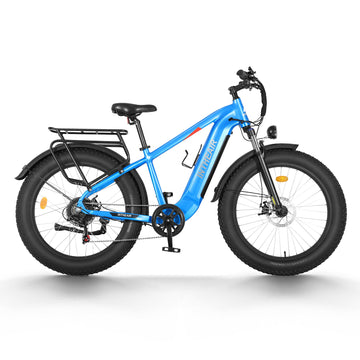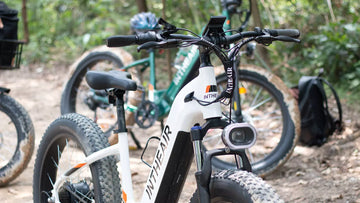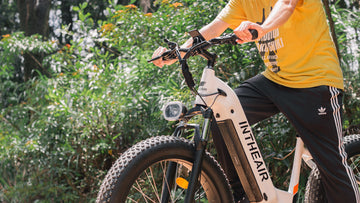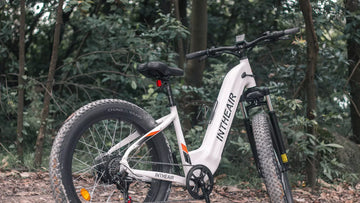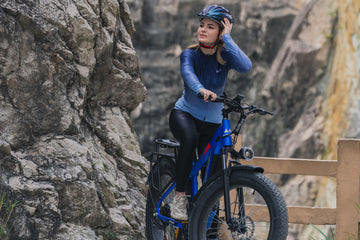As most riders know, e-bikes have pedal assist systems with cadence and torque sensors that make riding both more fun and easier to use. In addition to the throttle mode, the pedal assist system (PAS) of the e-bike can give you extra power, which makes it easier for you to ride.
Whether using throttle mode or assist pedal mode when you are riding, the cadence or torque sensor can perfectly combine power and electricity. The following is an introduction to the use of cadence sensors and torque sensors for electric bike and how to make the correct choice between cadence sensors and torque sensors.
Pedal Assist (Pas) and Throttle
All INTHEAIR Bikes are equipped with a pedal assist mode, which allows the rider to not only feel like a traditional bicycle when riding, but also PAS can provide forward power, and the motor and the rider's pedaling are smoothly and proportionally engaged Provides a more natural riding experience. So you will feel that the pedal will be easier if you use the Pedal Assist System (PAS) to help. The cadence sensor will provide output power according to your riding speed and pedaling cadence.
The pedal assist mode of the electric bike has the setting of the level of auxiliary power. You must know that not every rider wants to get the fastest speed. Therefore, almost all models of INTHEAIR Bike are designed with levels 0 (no assistance) to 5 (maximum assistance). You can choose the riding experience and assistance level that suits you according to your riding needs.Despite the convenience and control they offer, it's critical to consider and follow the local laws in your area governing e-bikes with gas and pedal assist.
What is the difference between cadence and torque sensor
Cadence and torque sensors have essential differences and functions on bicycles, helping riders experience different performance and experience.As innovations continue to emerge, even seasoned riders need to learn more about e-bike features (such as throttles and sensors) and how they work.
What Does A Cadence Sensor Do On An Electric Bike
The cadence sensor calculates the cadence by monitoring the speed of the rider, in other words, by detecting the number of times the rider depresses the pedals. Obviously, when the rider feels the information from the cadence sensor, he will maintain a stable and efficient pedaling frequency according to the frequency of the sensor. The data provided by the cadence sensor can be used for rider training and performance analysis, such as tracking average cadence, setting goals and measuring improvement progress.
What Does A cadence Sensor Do On An E-Bike
The cadence sensor calculates the cadence by monitoring the speed of the rider, in other words, by detecting the number of times the rider depresses the pedals. Obviously, when the rider feels the information from the cadence sensor, he will maintain a stable and efficient pedaling frequency according to the frequency of the sensor; the motor controller controls the electric power assist of the motor. The data provided by the cadence sensor can be used for rider training and performance analysis, such as tracking average cadence, setting goals and measuring improvement progress.
If you want to get full exercise while riding, then choose an electric bike with a cadence sensor. Electric bikes like the INTHEAIR ROCKET Electric Mountain Bike with throttle and pedal-assist capabilities typically feature a cadence sensor. When riding an adventure or on the road, the speed at which you are riding and the size of the derailleur gear you choose will determine how fast or slow your gear selection will be. This can make the rider experience the fun of riding more.
What Does A Torque Sensor Do On An Electric Bike
The torque sensor is used to measure the torque produced by the rider when pedaling, that is, the amount of force the rider applies to the pedals. The biggest advantage of torque sensors over pedals is that the rider can operate the motor by twisting, pushing a lever, or pressing a button without pedaling. When the rider presses the accelerator, the sensor sends a signal to the motor controller to start the motor. Provides a corresponding degree of electric assist. Torque sensors are more sensitive and responsive than cadence sensors, which means they provide a boost that better matches the rider's needs.
What Level Of Pedal Assist Should I Use When Riding An E-Bike
Level of Pedal Assist to Use
If you just got your first e-bike and are inexperienced with riding it, it is recommended that you start with a first-level pedal assist device. The assist pedal system will only provide assistance when you are pedaling, and will not provide energy assistance during other riding conditions, such as coasting or braking. Plus, it’s a smart choice for those who are uneasy about riding fast and going up hills. If you are going uphill, the motor can help you provide energy to maintain speed and help you climb more easily. However, if you slow down once, the output of the motor may not allow you to return to the original speed; at this time, you can use the throttle mode to compensate for the power loss. If you have years of experience riding an e-bike, you can choose to use pedal assist any time you want. Most experienced riders prefer level 5 assist, especially on hills, because the assist level tells you how much the battery or motor is outputting. You can use level 3 or 4 depending on the slope of the hill.
There are many benefits to owning an INTHEAIR e-bike, and choosing one with the right motor power and an assisted pedal mode can make a big difference. It can determine the amount of assistance you need to climb hills and over obstacles as well as your overall experience on an e-bike. For example, your INTHEAIR ROCKET ST All Terrain Electric Fat Bike is equipped with an upgraded motor with 750W of power and a maximum motor torque of 85Nm.
Conclusion
At present, electric bike on the market are equipped with an auxiliary system mode. This system can not only provide power assistance to the rider, but also allow them to experience the joy of riding. Both the torque sensor and the speed sensor have their own advantages. When you use the assist mode, you must choose the best assist mode that suits you according to your riding habits and riding environment. By knowing and using them safely, riders can enjoy a safe, unique and fun e-bike experience.

